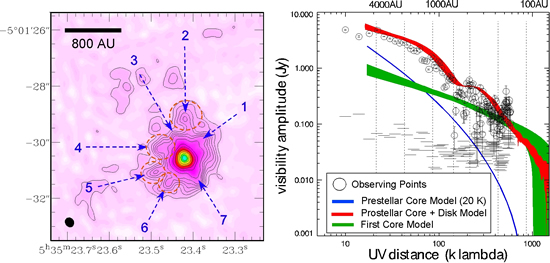Spatially Resolving Substructures within the Massive Protostellar Envelope in Orion

Left: 850 micron continuum image obtained with SMA. Right: Visibility-amplitude plot overlaid with modeled prestellar and protostellar cores.
Highest angular resolution achieved with the SMA 850 micron continuum observations (0.3 arcsec) has revealed detailed spatial structures within a massive protostellar envelope, MMS 6-main located in the Orion Molecular Cloud 3 region (left panel of the figure). The observing data show the extremely high column density (1.5x10^10 cm^-3) and warm gas (T > 52K) in the central 120 AU. Detailed model comparisons clearly show that the self-luminous source is necessary to explain the observed high flux density (right panel of the figure), suggesting that MMS 6 is one of the first cases of an intermediate-mass protostellar core at an extremely young stage. In addition to the central component, we have also spatially resolved a number of spiky structures and sub-clumps, distributed over the central 1000 AU (denoted as 1-7 in the right panel of the figure). The masses of these sub-clumps are estimated to be 0.066-0.073 M_sun, which are on the order of brown dwarf masses. These structures might be originated from fragmentations, spiral arms, or inhomogeneity within the disk-like structures/envelope. (Takahashi, S., Saigo, K., Ho, P. T. P., & Tomida, K., 2012, ApJ, 752, 10)